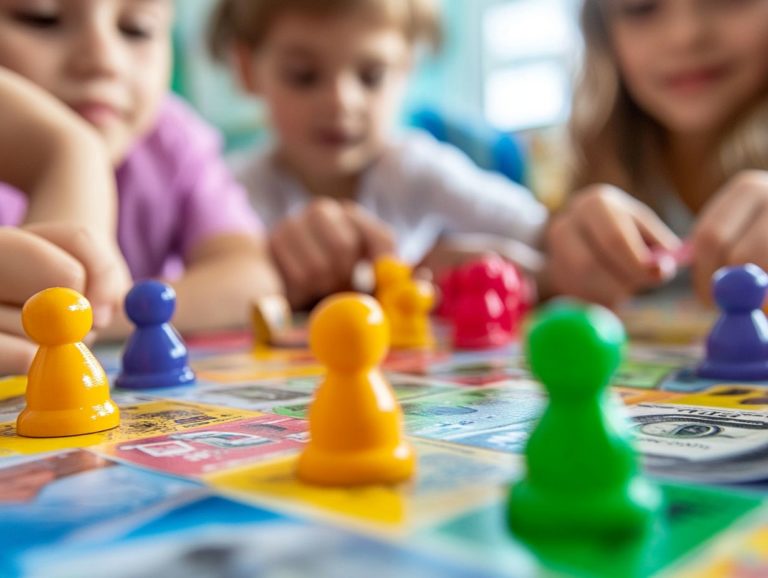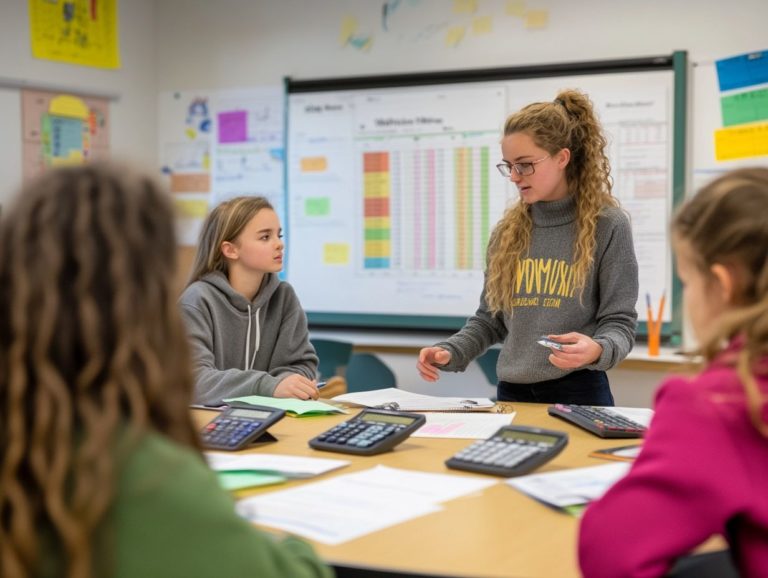How Can Children Learn to Compare Prices and Shop Smart?

Neale Godfrey is the financial voice for women and multi-generations and a world-renowned speaker and author, who has inspired millions through her work. She motivates, trains, educates, and frankly, entertains by delivering her core message: Empower yourself to take control of your financial life.
In today’s consumer-driven world, teaching children to compare prices and shop smart is essential for their financial literacy.
Understanding money management can empower them to make informed decisions that last a lifetime.
Find out the best age to start teaching these ideas, the fundamental rules of money, and practical ways to teach these skills through engaging activities.
Learn how to support a generation with both shopping in person and playing fun games. savvy shoppers who can navigate their financial futures with confidence.
Key Takeaways:
Why Teach Children to Compare Prices and Shop Wisely?

Teaching kids how to compare prices and shop carefully is key for giving them the ability to handle a budget throughout their lives. By learning why comparing prices is important and how personal values affect choices, parents can help their children make wise purchases.
This basic lesson encourages kids to shop wisely and manage their money as they get older. The skills they learn from this activity can help them make better purchases and save more money, creating an ongoing alertness to costs. As noted by a respected source from Investopedia, teaching financial literacy early on is essential for developing these vital financial management skills in children. For those looking to delve deeper into the importance of financial literacy, explore further insights and resources related to kids’ financial literacy.
At What Age Should Children Start Learning About Money Management?
Children can start learning about managing money as early as preschool, when they begin to understand basic ideas about money and its value.
By teaching financial skills early, parents build a strong base for learning budgeting skills and shopping habits that will help them throughout life.
According to the Consumer Financial Protection Bureau, teaching children about money gradually, including ideas like saving and careful spending, can help them become wise shoppers and make good financial choices as they grow up. The bureau’s guide on money milestones for young children provides practical steps for parents to nurture these skills from an early age. For a deep dive into enhancing financial literacy, exploring the importance of financial literacy for kids could offer valuable insights on how these early lessons impact long-term understanding.
What Are Some Basic Concepts Children Should Understand About Money?
Basic concepts of money that children should understand include the value of money, the importance of saving, and the difference between needs and wants. Grasping these basic ideas helps them learn how to handle money and make wise shopping decisions.
By introducing these ideas in relatable scenarios, such as comparing the cost of a toy versus a necessary school supply, children can better understand why saving is essential. According to insights from FINRA, creating relatable financial scenarios is a key strategy in financial education for children.
For instance, explaining that saving up for a special video game requires prioritizing their allowance over instant gratification from candy can reinforce the importance of patience and goal-setting.
Discussing real-life situations, like deciding between a pizza or a healthier packed lunch, illustrates how distinguishing needs from wants can lead to healthier choices.
Teaching these ideas early will help them make decisions now and handle money better as they grow up.
How to Teach Children About Comparing Prices and Making Wise Purchases?
Teaching kids to look at prices and make good purchases benefits both parents and children. Start by discussing why checking prices is key to spending money wisely.
Show them how to make a shopping list and recognize store prices to improve their shopping habits. By introducing these budgeting and shopping skills early on, children can make better decisions in various shopping situations. For a hands-on approach, consider the 5-minute Price Detective activity, which provides simple steps to engage kids in price awareness and smart spending (our 5-Minute Price Detective: Activity Steps guide explains how to get started).
1. Start with Simple Concepts
It’s important to begin with basic ideas when teaching children about managing money. This provides a foundation for learning more advanced financial topics. For instance, introducing the idea of saving money for specific goals or distinguishing between needs and wants can help children develop strong budgeting skills.
These simple lessons match what customers value, showing them why it matters to make informed shopping choices.
Having children participate in activities, such as creating a make-believe store at home, can help explain the difference between things they need and things they want. Parents can have them choose items they want from the store while using play money, encouraging discussions on whether each item is essential or a luxury.
Creating a colorful savings chart can motivate children to visualize their savings progress and celebrate small milestones. For example, if they want a toy that costs $20, they can track their savings by coloring sections of the chart as they save, turning the concept of budgeting into a fun and interactive learning experience.
These relatable experiences make the lessons easy to remember and help encourage a responsible approach to handling money.
2. Use Real-Life Examples
Teaching kids with real-life scenarios can improve their ability to manage money and make wise purchasing decisions. Parents can involve their kids in grocery shopping trips to illustrate the concepts of price comparison and the impact of consumer choices. By discussing product reviews and brand comparison during these outings, children can better understand how to assess value and make informed purchasing decisions.
Parents might consider planning specific budget-friendly meal preparation tasks, where children can help select items from a pre-established list while remaining within a set budget. This strengthens budgeting skills and promotes working together and organizing.
Another chance comes up during back-to-school shopping, where kids can learn to differentiate between what they need and what they want, helping them grasp how to manage resources. Taking part in these situations promotes careful thinking, making conversations about money a regular part of daily life. This helps get them ready to manage their own finances responsibly later on.
3. Involve Children in the Shopping Process

Including children in shopping helps them learn practical skills about shopping and managing money. Helping children make a shopping list and compare prices helps them get involved in choosing what to buy. This hands-on experience helps them understand shopping wisely and builds their sense of responsibility as consumers, which will help them later on.
When kids are asked to do easy things like picking snacks or looking at price differences, they gain confidence and learn how money works in daily life.
This interactive approach nurtures critical thinking and problem-solving skills as they weigh different factors, such as quality versus price.
Parents can improve this experience by talking about why decisions are made, which helps kids understand budgeting better.
Involving children in these activities makes shopping trips into useful opportunities for learning, helping them get ready for bigger financial tasks as they get older.
4. Encourage Critical Thinking
It’s important to teach children to think carefully and make informed choices about spending and managing money. Encouraging them to ask questions about the products they want, such as ‘Is this worth the price?’ or ‘What are the features compared to similar products?’ helps them think critically and be aware of costs. Developing this critical thinking skill helps children align their purchases with their consumer values, ensuring they prioritize quality and necessity over impulse buying.
Incorporating these strategies during shopping trips can turn an ordinary errand into an engaging learning opportunity. For instance, parents can initiate discussions about product sustainability, brand reputation, and even the ethical implications of certain purchases.
Getting kids to look at prices from various stores or websites can improve their ability to make choices. Setting a budget for a shopping trip inspires them to weigh options carefully.
Teaching critical thinking in discussions about shopping helps people spend wisely and builds key skills useful in many areas of life, not just money management.
What Are Some Fun Ways to Teach Children About Money Management?
Teaching children about money can be both educational and enjoyable through a variety of interactive activities. Using games and challenges, like budgeting exercises or pretend money games, allows children to learn while having fun.
These enjoyable methods teach kids about money and help them develop shopping skills and awareness as consumers, which will be useful as they grow up. One of our most insightful guides on this topic highlights the types and benefits of financial literacy games, further enriching their learning experience.
1. Play Money Games
Games involving money can be fun and teach children about managing money and learning financial skills. These games can range from board games that simulate shopping experiences to online interactive platforms that teach budgeting and saving. By participating in these fun tasks, children gain important abilities and have the chance to make choices in a safe environment.
These activities often include scenarios that mimic real-life choices, such as planning a budget for a birthday party or deciding what to buy with their allowance.
By dealing with these matters, kids can learn how to handle money, make sensible purchasing decisions, and save for upcoming plans.
When students work with their classmates, they support teamwork and build friendships, turning learning into a group effort. Mixing games with learning helps kids develop positive views about money, aiding them in making wise financial decisions as they mature.
2. Create a Budgeting Challenge
Setting up a budgeting challenge can be a fun way to show children how to handle money and make financial choices.
By using real-life examples, such as planning a small birthday party or buying groceries for a week, children can understand the need to make choices when they have a set amount of money.
For instance, they could receive a virtual allowance that they must stretch over various fun activities, like selecting snacks for a picnic or choosing decorations for their room. These activities engage them creatively and teach useful money-handling skills.
When children deal with these situations, they learn how to keep track of expenses, figure out the difference between needs and wants, and even learn the skill of saving for big buys. This helps them develop a sense of handling money well, which will be useful as they get older.
3. Have a Family Garage Sale
Hosting a family garage sale can provide a hands-on learning opportunity for children to grasp concepts of money management and consumer values. Involving children in the organization, pricing, and selling of items teaches them the importance of pricing strategies and negotiation. This fun activity helps build financial knowledge and encourages responsibility and appreciation for earning money.
The process lets kids take part in going through their things, deciding what to keep and what to sell. This helps them improve their ability to think and make choices.
By creating eye-catching signs and determining the best strategies to attract customers, children learn marketing fundamentals while practicing teamwork and collaboration with family members.
As they interact with potential buyers, they can practice communication skills and even experience the ups and downs of their efforts in real time.
These engaging activities make learning fun and help students remember financial ideas, which can help them make better choices later on.
How to Encourage Children to Save Money?

Teaching kids how to save money is an important part of helping them learn how to manage money and make good choices.
Setting savings goals for things like a toy or a tech gadget gives kids a clear target. Parents can teach good budgeting habits and discuss the benefits of saving to help their children build lifelong money management skills. Learn more about effective strategies to set and achieve short-term savings goals for kids that make the process engaging and educational.
1. Set Savings Goals
Setting savings goals gives children a clear target for their money, helping them understand the idea of saving better. By helping children define specific savings goals, such as purchasing a toy or saving for an outing, parents can teach them the value of budgeting skills and delayed gratification. This approach encourages responsibility and emphasizes the need for matching their spending habits with their personal beliefs.
In guiding their children through this process, parents can emphasize the significance of each savings goal, explaining how small achievements lead to larger financial aspirations.
For example, if a child wants a new bicycle, dividing the total cost into smaller, manageable steps can make the goal feel easier to reach.
Utilizing tools like visual savings charts or apps can effectively track progress, instilling a sense of accomplishment as they move closer to their targets.
This hands-on involvement teaches financial knowledge and helps parents and children grow closer by working together and discussing good spending habits.
2. Offer Incentives
Offering incentives can motivate children to save money and make informed financial decisions. Parents can introduce rewards for reaching savings milestones or for practicing consistent saving habits. These rewards support good money habits and also show children the advantages of meeting financial targets with hard work and careful planning.
Parents can create an enjoyable and interesting savings atmosphere by using different rewards. For instance, small rewards might include a special outing for meeting a savings target, while bigger achievements could lead to experiences like a weekend trip or a family activity of their choice.
This approach makes the process fun while teaching budgeting and the value of waiting.
Helping children visually track their progress can make learning about money more fun and less of a task.
3. Lead by Example
Leading by example is one of the most effective ways for parents to instill good money management habits in their children. By demonstrating responsible financial decisions and showcasing the importance of saving and budgeting in their own lives, parents provide a practical blueprint for children to follow. This method helps teach children about money and improves the bond between parents and children through talking about finances together.
In daily interactions, parents can discuss their shopping choices, such as comparing prices or opting for quality over quantity, which illustrates critical thinking in spending.
Getting kids involved in budgeting tasks, such as planning a family trip or saving for something special, helps them learn about what is important and what the limits are.
Talking about how to earn, spend, and save money can make financial concepts clearer, assisting younger people in making informed decisions.
Talking openly about financial decisions helps teach family members and builds an environment of trust and respect.
What Are Some Common Mistakes Parents Make When Teaching Children About Money?
Parents often make common mistakes when teaching children about handling money, which can delay their learning. These mistakes include:
- Not being consistent with lessons
- Not discussing money openly
- Not allowing kids to learn from their financial mistakes
Solving these issues is important for helping children develop good spending habits and understand budgeting and wise shopping.
1. Not Being Consistent
One of the most significant mistakes parents make is not being consistent when teaching their children about money management. Mixed messages can cause confusion and make it harder for people to learn about managing money. Teaching kids regularly about budgeting, saving, and shopping habits strengthens key ideas and helps them understand the need for careful handling of money.
For instance, if parents advocate for saving but frequently indulge in impulsive purchases themselves, it sends mixed signals to their children about the value of saving.
Strategies to maintain a steady approach include:
- Setting regular family discussions about financial goals,
- Involving children in budgeting for family outings, and
- Creating a gradual system for allowance tied to responsibilities.
When parents openly share their financial choices and follow their own advice, they can build a solid base of money skills that children will keep as they grow up.
2. Not Discussing Finances Openly

Not talking about money openly is another mistake parents often make, which can reduce children’s awareness and knowledge about financial choices. When parents don’t talk about managing money, such as how to budget, save, and spend, children miss important lessons that can help them handle money wisely as they grow up. Open conversations about money management encourage children to engage, ask questions, and develop a healthy attitude towards financial matters.
This approach teaches children why it’s important to make good choices with their money. Parents can encourage these talks by including money-related topics in daily conversations, like when buying groceries or organizing family trips.
Letting children manage a small amount of money for certain things helps them learn how to make choices and realize why it’s important to choose needs before wants. Regularly reviewing expenses together and celebrating successful savings goals can also instill a sense of accomplishment, further deepening their comprehension of responsible shopping and financial literacy that will benefit them throughout their lives.
3. Not Allowing Children to Make Mistakes
Not allowing children to make mistakes can hinder their ability to learn from real-world financial experiences. Although it’s necessary to advise them, allowing children to deal with the results of bad financial choices-like buying things without thinking-can be important for their development. These activities help children learn to make smart decisions with money and improve their ability to handle financial problems.
When children make choices, such as overspending their allowance on unnecessary toys or snacks, they encounter the reality of their budget limitations. These acceptable mistakes serve as practical lessons, teaching them to evaluate needs versus wants.
Under supportive guidance, parents can facilitate discussions about these experiences, allowing children to process their decisions and understand the repercussions of their actions. For example, if a child buys a game and later wishes they hadn’t, talking about opportunity cost can help them think more critically.
By viewing errors as chances to talk and learn, children can face difficulties and develop their knowledge of managing money.
How Can Parents Help Children Apply These Skills in Real Life?
Parents play an important role in helping children use the skills they’ve learned about managing money in real-life situations.
By giving children a budget for specific purchases and letting them make their own shopping choices, parents can improve their child’s knowledge of financial literacy and teach responsible shopping habits.
Talking with children about shopping plans before and after trips can also strengthen their learning and encourage careful financial decisions.
1. Give Children a Budget for Specific Purchases
Letting children have a set amount of money for certain things helps them learn to make financial choices and handle money. By setting a clear budget for a shopping trip, parents can encourage children to engage in price comparison and evaluate their shopping choices. This activity teaches them how to handle money and why it’s important to track spending and make wise decisions.
When children participate in the budgeting process, they learn to prioritize their wants and needs effectively.
For instance, if a child has a budget of $50 for back-to-school supplies, they can allocate a portion towards essentials like notebooks and pencils, while having the freedom to select a fun item like a new backpack or lunchbox.
By guiding them to assess quality versus quantity, parents can help kids understand the value of their money.
Discussing with kids how to use money for fun, gifts, or saving for big buys helps them learn about finances and how to manage money.
2. Allow Children to Make Their Own Purchases
Allowing children to make their own purchases is a critical step in developing their financial independence and responsible shopping behavior. When parents let kids use their own money, they can learn important lessons about handling a budget, deciding the value of things, and seeing how their spending choices affect them. This practical activity helps children build their confidence in making money-related decisions.
Such practices can begin with simple scenarios, like letting them choose a snack at the grocery store or a toy within a set budget during a shopping trip. These situations encourage them to weigh options and consider if something is truly worth the cost.
When children make small financial choices, they understand how to prioritize what they want versus what they need. These activities help build independence and start discussions about saving, sharing, and investing, which are important parts of managing personal finances.
Engaging in this participatory process equips kids with skills that will last a lifetime.
3. Talk About Effective Ways to Shop Before and After Your Trips
Discussing shopping plans with kids before and after going to the store is a good way to teach them about handling money and making financial decisions. By engaging children in conversations about what to expect in terms of prices and shopping choices, parents can prepare them for real-life scenarios. After shopping, reflecting on the decisions made can solidify their learning and encourage them to think critically about their consumer awareness.
Before going to the store, it’s important to discuss set spending limits and motivate kids to think about their spending choices and the reasons some things might be worth more than others.
Parents might ask questions like, ‘What are some affordable options here?’ or ‘How can we compare prices between similar products?’ After the shopping experience, discussions can focus on what items were bought and whether they met the initial goals.
Questions like, ‘Did we keep to our budget?’ or ‘Did we buy anything unnecessary?’ encourage thinking about past decisions. These talks help children learn about money and teach them wise shopping habits, getting them ready to be successful and informed buyers as adults.

Neale Godfrey is the financial voice for women and multi-generations and a world-renowned speaker and author, who has inspired millions through her work. She motivates, trains, educates, and frankly, entertains by delivering her core message: Empower yourself to take control of your financial life.






